Global E-business - Nike and Puma
Added on 2022-08-25
28 Pages2366 Words15 Views
Running head: GLOBAL E-BUSINESS
GLOBAL E-BUSINESS
Name of the Student
Name of the University
Author Note
GLOBAL E-BUSINESS
Name of the Student
Name of the University
Author Note
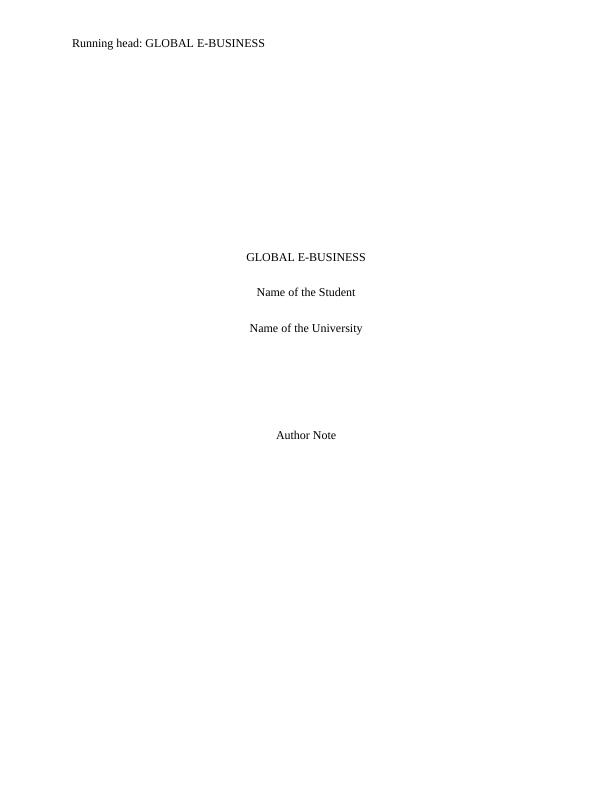
GLOBAL E-BUSINESS
1
Table of Contents
Introduction......................................................................................................................................2
Main Findings..................................................................................................................................2
Analysis...........................................................................................................................................6
Customer Journey Map................................................................................................................6
Conclusion & Recommendations....................................................................................................7
References........................................................................................................................................9
Appendix A - Puma.......................................................................................................................11
Appendix B – Nike........................................................................................................................15
1
Table of Contents
Introduction......................................................................................................................................2
Main Findings..................................................................................................................................2
Analysis...........................................................................................................................................6
Customer Journey Map................................................................................................................6
Conclusion & Recommendations....................................................................................................7
References........................................................................................................................................9
Appendix A - Puma.......................................................................................................................11
Appendix B – Nike........................................................................................................................15
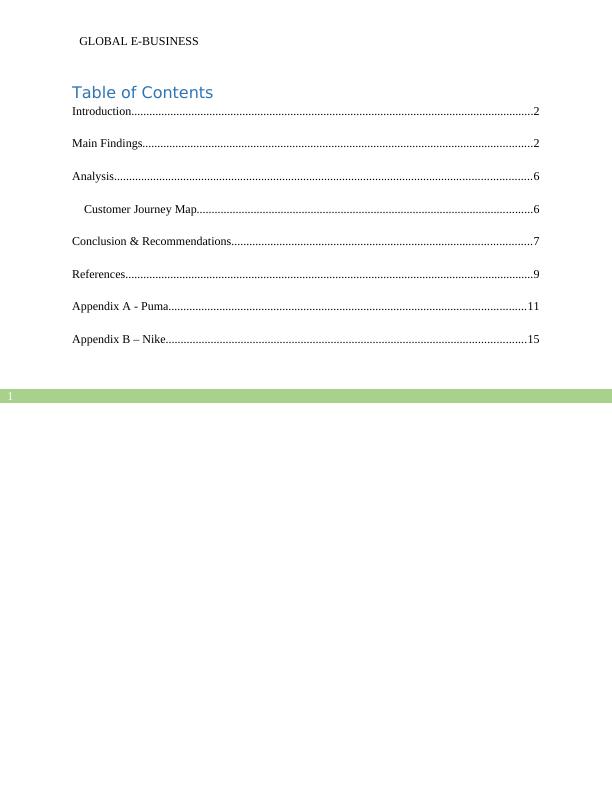
GLOBAL E-BUSINESS
2
Introduction
Every E-commerce organization has the goal to reach consumers to improve their
business. They make sure the promotions and advertisements are seen by the customers. Many
marketing techniques are implemented to influence the customers for years (Cardenas et al.
2017). The Internet has enabled all the aspects for an E-commerce company to grow their
business. Specially the B2C (Business to Customer) companies have achieved better reachability
to the consumers. The current value of the B2C Companies in the market is very high (Panda
2014). In this report, two B2C merchants Puma and Nike will be evaluated and compared in
terms of the customer experience and their offerings. This will help in determining the success of
the websites. However, both companies are successful and comes from almost a same domain of
business. Hence, comparison will be difficult. To overcome this challenges, this paper will
develop and model which aims to evaluate the customer journey Map of five key stages. It will
help in evaluating the website in a quantitative way.
Main Findings
A customer journey map helps in explaining the use experience which is structured into 5
stages of the journey. The Stages defines the different sections of a single purchasing task on a
B2C website (Vázquez et al. 2014). The five key stages are Site landing, Product Discovery,
Product Presentation, Cart management and checkout. Each of the stages have multiple
parameters which is the collection of the ideal ecommerce features (Wolny and Charoensuksai
2014). It varies from the basic to bet practices solutions looking for a single feature in whole
model. In the Evaluation of the Puma and Nike Website, a normal task is performed to buy some
2
Introduction
Every E-commerce organization has the goal to reach consumers to improve their
business. They make sure the promotions and advertisements are seen by the customers. Many
marketing techniques are implemented to influence the customers for years (Cardenas et al.
2017). The Internet has enabled all the aspects for an E-commerce company to grow their
business. Specially the B2C (Business to Customer) companies have achieved better reachability
to the consumers. The current value of the B2C Companies in the market is very high (Panda
2014). In this report, two B2C merchants Puma and Nike will be evaluated and compared in
terms of the customer experience and their offerings. This will help in determining the success of
the websites. However, both companies are successful and comes from almost a same domain of
business. Hence, comparison will be difficult. To overcome this challenges, this paper will
develop and model which aims to evaluate the customer journey Map of five key stages. It will
help in evaluating the website in a quantitative way.
Main Findings
A customer journey map helps in explaining the use experience which is structured into 5
stages of the journey. The Stages defines the different sections of a single purchasing task on a
B2C website (Vázquez et al. 2014). The five key stages are Site landing, Product Discovery,
Product Presentation, Cart management and checkout. Each of the stages have multiple
parameters which is the collection of the ideal ecommerce features (Wolny and Charoensuksai
2014). It varies from the basic to bet practices solutions looking for a single feature in whole
model. In the Evaluation of the Puma and Nike Website, a normal task is performed to buy some
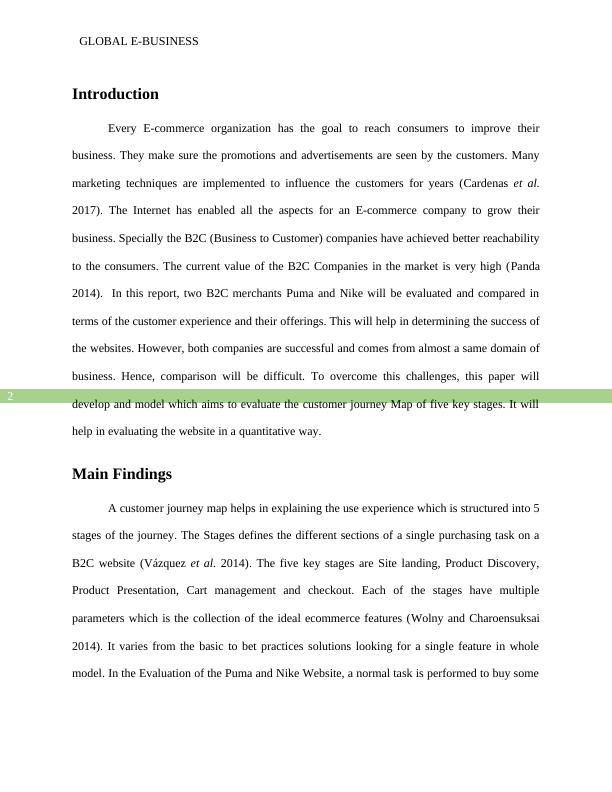
GLOBAL E-BUSINESS
3
shoe products on their official websites. The whole task is described according to the five stages
of the customer journey below:
a. Site Landing: This stage focuses on the entering of the user on the homepage of the
website. The user experience starts from here itself. All the main E-commerce page are
related with the main homepage of the website. The landing on the homepage can be
done in different ways such as using search engines, promotional advertisements and
URL Ortiz-(Cordova and Jansen 2014).
For Puma, the site Landing has been done using the Google search engine. The first
results lands on the homepage of the Puma. On their homepage, Offers are present in the
form of banner. Search box, navigation bar, logo, user management and cart options are
also present in the homepage (PUMA.com | Forever Faster., 2020).
For Nike, the site landing has been done using the Google Search engine. On their
homepage, product promotion, search box, subcategories, logo, cart management and
user management links are present along with the location setter. Above the banner, a
notification is given that the deliveries are late currently (Nike, 2020).
b. Product Discovery: Product discovery is a step where the user finds the product which
he desires to purchase. It can be done by using search boxes to search the name of the
product, using subcategories and catalogues (Moon et al. 2016). Also, the promotional
banners are included in case of very famous or new product.
Puma has the options categorized as Women, Men, Kids, and Collections etc. The
Product discovery has been done using the search box in the homepage of the website.
The search is done for the keyword sports shoe. The returned results have multiple filters
such as tye, price, size and color etc. (PUMA.com | Forever Faster., 2020).
3
shoe products on their official websites. The whole task is described according to the five stages
of the customer journey below:
a. Site Landing: This stage focuses on the entering of the user on the homepage of the
website. The user experience starts from here itself. All the main E-commerce page are
related with the main homepage of the website. The landing on the homepage can be
done in different ways such as using search engines, promotional advertisements and
URL Ortiz-(Cordova and Jansen 2014).
For Puma, the site Landing has been done using the Google search engine. The first
results lands on the homepage of the Puma. On their homepage, Offers are present in the
form of banner. Search box, navigation bar, logo, user management and cart options are
also present in the homepage (PUMA.com | Forever Faster., 2020).
For Nike, the site landing has been done using the Google Search engine. On their
homepage, product promotion, search box, subcategories, logo, cart management and
user management links are present along with the location setter. Above the banner, a
notification is given that the deliveries are late currently (Nike, 2020).
b. Product Discovery: Product discovery is a step where the user finds the product which
he desires to purchase. It can be done by using search boxes to search the name of the
product, using subcategories and catalogues (Moon et al. 2016). Also, the promotional
banners are included in case of very famous or new product.
Puma has the options categorized as Women, Men, Kids, and Collections etc. The
Product discovery has been done using the search box in the homepage of the website.
The search is done for the keyword sports shoe. The returned results have multiple filters
such as tye, price, size and color etc. (PUMA.com | Forever Faster., 2020).
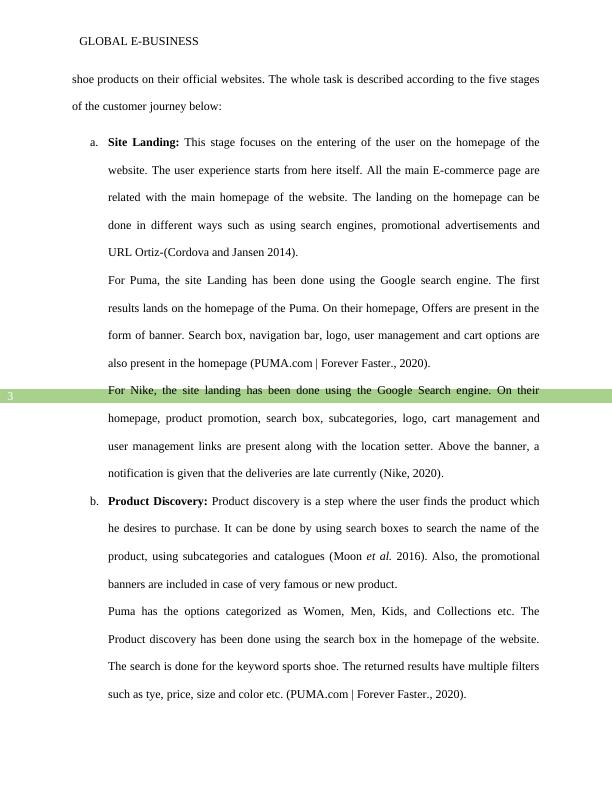
GLOBAL E-BUSINESS
4
On other hand, Nike has a top suggestion features for its search box. The searched item
on the website is running shoes and the resulted page has multiple filters, even more than
the Puma’s website (Nike, 2020). The provided fitters are the gender, kids, product type,
closure type, icon, surface, brand, technology and sports etc.
c. Product Presentation: Product presentation is a vital stage of the customer journey. All
the product description should be available here so the physical evaluation of the product
is not required for purchasing (Yoo and Kim 2014). It represents the completeness of the
product presentation of a brand.
For Puma, the products presentation is comprising of price tag, tax, images of the product
from different angles, size and description of product. Below the description, ratings,
review, Question & answer a shipping information details are explained. Add to cart
options is also provided (PUMA.com | Forever Faster., 2020).
For Nike, their product presentation is better than the Puma’s website. It has provided
price, and a large numbers of sizes (may be due to different popularity of the products).
Also, reviews, advices, return policies and free delivery options were provided in the
presentation. Images have been presented with view of all angles along with a video of
product (Nike, 2020). Add to cart options is also provided.
d. Cart Management: Cart management only focuses on the selected products. Before this,
all the stages focused on the multiple products before adding into the cart (Muntean,
TÂRNĂVEANU and Ion 2016). It saves the selected products along with the total value
of the cart.
On Puma’s cart, it represents the subtotal of the cart, estimated total which is calculated
considered the promo codes and tax. A promo code box is provided to avail offers. Two
4
On other hand, Nike has a top suggestion features for its search box. The searched item
on the website is running shoes and the resulted page has multiple filters, even more than
the Puma’s website (Nike, 2020). The provided fitters are the gender, kids, product type,
closure type, icon, surface, brand, technology and sports etc.
c. Product Presentation: Product presentation is a vital stage of the customer journey. All
the product description should be available here so the physical evaluation of the product
is not required for purchasing (Yoo and Kim 2014). It represents the completeness of the
product presentation of a brand.
For Puma, the products presentation is comprising of price tag, tax, images of the product
from different angles, size and description of product. Below the description, ratings,
review, Question & answer a shipping information details are explained. Add to cart
options is also provided (PUMA.com | Forever Faster., 2020).
For Nike, their product presentation is better than the Puma’s website. It has provided
price, and a large numbers of sizes (may be due to different popularity of the products).
Also, reviews, advices, return policies and free delivery options were provided in the
presentation. Images have been presented with view of all angles along with a video of
product (Nike, 2020). Add to cart options is also provided.
d. Cart Management: Cart management only focuses on the selected products. Before this,
all the stages focused on the multiple products before adding into the cart (Muntean,
TÂRNĂVEANU and Ion 2016). It saves the selected products along with the total value
of the cart.
On Puma’s cart, it represents the subtotal of the cart, estimated total which is calculated
considered the promo codes and tax. A promo code box is provided to avail offers. Two
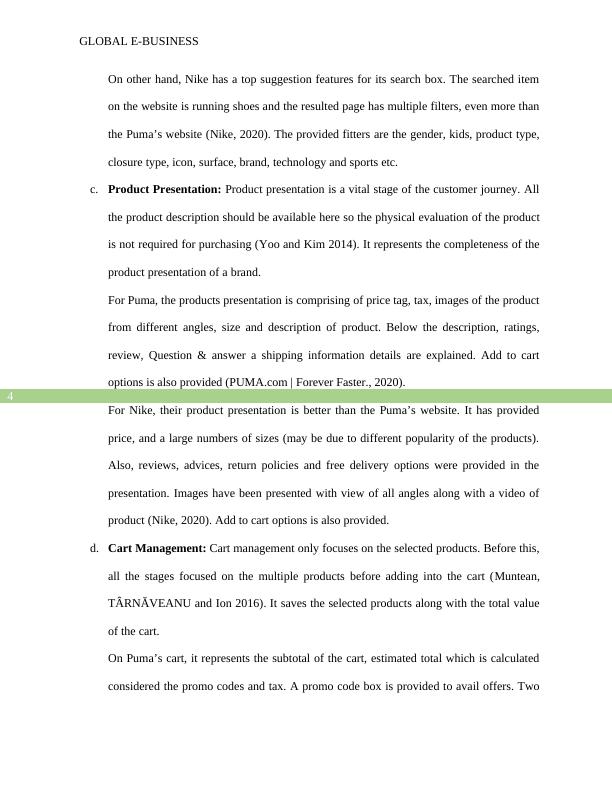
GLOBAL E-BUSINESS
5
types of checkout is provided- one on Puma’s website, and other will redirect to the
PayPal’s portal (PUMA.com | Forever Faster., 2020). Edit, remove and increasing
quantity options have been provided for exiting products in the cart.
On Nike’s cart, summary has been provided including, promo code and delivery options.
Login & Signup options are given also for better analytical results of favorite products
based on the past orders and searches (Nike, 2020). Payment option has been given direct
to the PayPal’s portal. It also displays that the delivery for the members is free of cost.
e. Checkout: It is the most critical phase of the journey where the shipping details, account
details have been entered along with the payment making for purchasing the products
(Kowalkiewicz, Rosemann and Dootson 2017).
In Puma’s website, login is not mandatory for placing order. However it requires email
and phone number for future communications. It needs the basic information such as
name, address, email and contact. The billing and shipping address can be same or
different (PUMA.com | Forever Faster., 2020). Later during the check out, two payment
methods have been provided that are either using card or using PayPal.
On Nike’s website, it asks for login or checkout as guest. Checkout as guest requires
email, phone and name details for communication. The shipping details are entered by
the user manually such as address, street, location, city and zip code etc. payment options
available are the PayPal and credit/debit cards (Nike, 2020).
5
types of checkout is provided- one on Puma’s website, and other will redirect to the
PayPal’s portal (PUMA.com | Forever Faster., 2020). Edit, remove and increasing
quantity options have been provided for exiting products in the cart.
On Nike’s cart, summary has been provided including, promo code and delivery options.
Login & Signup options are given also for better analytical results of favorite products
based on the past orders and searches (Nike, 2020). Payment option has been given direct
to the PayPal’s portal. It also displays that the delivery for the members is free of cost.
e. Checkout: It is the most critical phase of the journey where the shipping details, account
details have been entered along with the payment making for purchasing the products
(Kowalkiewicz, Rosemann and Dootson 2017).
In Puma’s website, login is not mandatory for placing order. However it requires email
and phone number for future communications. It needs the basic information such as
name, address, email and contact. The billing and shipping address can be same or
different (PUMA.com | Forever Faster., 2020). Later during the check out, two payment
methods have been provided that are either using card or using PayPal.
On Nike’s website, it asks for login or checkout as guest. Checkout as guest requires
email, phone and name details for communication. The shipping details are entered by
the user manually such as address, street, location, city and zip code etc. payment options
available are the PayPal and credit/debit cards (Nike, 2020).
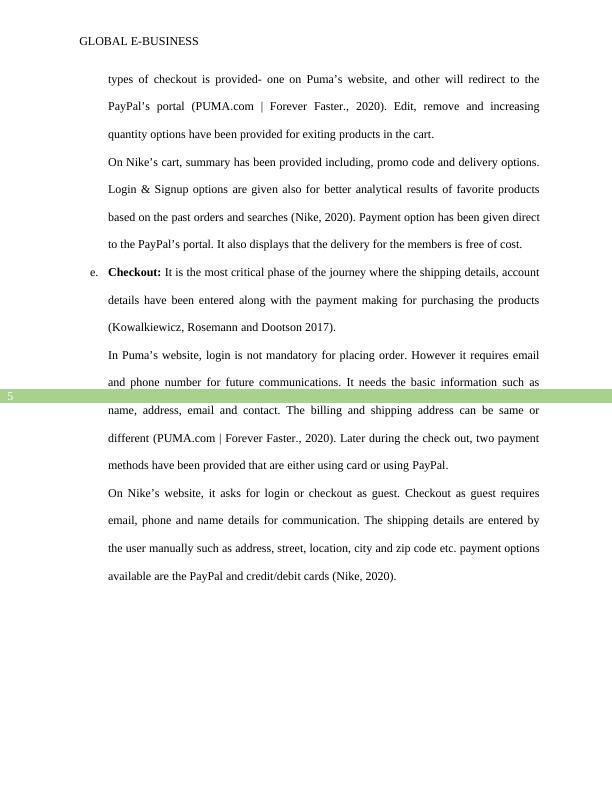
End of preview
Want to access all the pages? Upload your documents or become a member.
Related Documents
Analysis of the Customer Journey through Two Different E-Commerce Businesseslg...
|10
|2160
|182
Compare and Evaluate the Customer Journeys of H&M and ASOSlg...
|14
|1829
|235
Customer Journey Case Study 2022lg...
|8
|2017
|13
Unit 14 Website Design Sample Assignmentlg...
|5
|1236
|184
Design Analysis of Websiteslg...
|9
|2544
|68
Analysis of B2C E-commerce Model for Wealth Management and Odin Financial Advisorslg...
|20
|3483
|82
